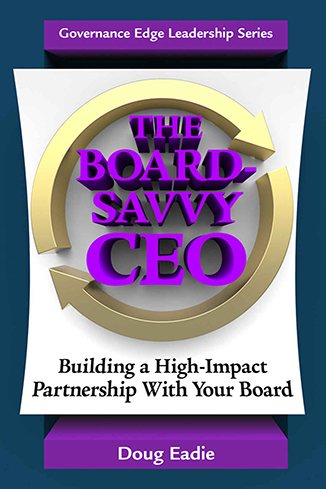 “What can I do to get my board meaningfully engaged in leading innovation and change in my organization?” I hear variations of this very important question quite often from CEOs in my one-on-one governance coaching sessions and educational workshops. There’s no simple answer, but the indispensable first step is to make sure you understand what’s going on in the rapidly evolving field of change planning and management. One thing for sure: traditional comprehensive, long-range “strategic” planning – for arbitrary periods like three or five years – is a blunt innovation tool. Experience has no doubt taught many if not most of my readers – as it has me – that traditional long-range planning is essentially an operational planning tool, projecting into the future what an organization is already doing (its programs, services, products). It can be very valuable in a number of ways, such as demonstrating to a foundation that your nonprofit is thinking beyond next year or explaining to the public at large what your nonprofit is all about in terms of priorities and programs. But it is not typically a productive innovation engine that generates out-of-the-box change.
“What can I do to get my board meaningfully engaged in leading innovation and change in my organization?” I hear variations of this very important question quite often from CEOs in my one-on-one governance coaching sessions and educational workshops. There’s no simple answer, but the indispensable first step is to make sure you understand what’s going on in the rapidly evolving field of change planning and management. One thing for sure: traditional comprehensive, long-range “strategic” planning – for arbitrary periods like three or five years – is a blunt innovation tool. Experience has no doubt taught many if not most of my readers – as it has me – that traditional long-range planning is essentially an operational planning tool, projecting into the future what an organization is already doing (its programs, services, products). It can be very valuable in a number of ways, such as demonstrating to a foundation that your nonprofit is thinking beyond next year or explaining to the public at large what your nonprofit is all about in terms of priorities and programs. But it is not typically a productive innovation engine that generates out-of-the-box change.
I’m not generally a fan of corporate CEO memoirs, but Robert Iger’s new book, The Ride of a Lifetime, is must reading for anyone interested in large scale organizational innovation. Iger, as you know, is chairman and CEO of the storied Walt Disney Company. Wearing the “Innovator-in-Chief” hat thoughtfully, aggressively, and courageously, he has on his watch spearheaded transformational change at the Walt Disney Company, dramatically strengthening the company’s content generation capacity (principally through the acquisition of Pixar, Marvel, Lucasfilm, and 21st Century Fox) while building a powerful streaming platform to provide content directly to the customer. He concludes his highly illuminating and entertaining account of dramatic change at Disney with a number of “lessons to lead by” that all CEOs can put to good use in leading innovation in their organizations, for example:
- “Now more than ever: innovate or die. There can be no innovation if you operate out of fear of the new.”
- “Value ability more than experience, and put people in roles that require more of them than they know they have in them.”
- “Don’t start negatively, and don’t start small. People will often focus on little details as a way of masking a lack of any clear, coherent, big thoughts.”
- “Too often we lead from a place of fear rather than courage, stubbornly trying to build a bulwark to protect old models that can’t possibly survive the sea change that is under way.”
- “Long shots aren’t usually as long as they seem. With enough thoughtfulness and commitment, the boldest ideas can be executed.”
Not theoretically exciting, basically common sense, these and the other lessons in the Appendix of The Ride of a Lifetime nonetheless provide the reader with valuable insights that help to explain Iger’s phenomenal success as a transformational leader. Since Robert Iger is without question a visionary CEO par excellence, my readers might want to check out an earlier post at this blog, “Vision: Your Board’s Driver of Innovation and Change:” https://www.dougeadie.com/vision-boards-driver-innovation-change/.
I’d love to hear from other CEOs about their experiences in leading out-of-the-box innovation in their organizations.





